|
The Principal Streams
of the County of York.—The Credit.—Origin of its Name.—Peter Jones and
Egerton Ryerson at the Credit Mission. — Indian Witchcraft. — The
Humber.— The Don. — Sir Richard Bonnycastle's Account of a Ride Through
the County Thirty-eight Years Since.—Richmond Hili. Without the Pass.—
Tiiornhill.—The Blue Hill.—List of County Wardens.—The Municipal
Council.—Officers Appointed by the Council.—Tables of Values.
A TOLERABLY full
account of the milling and other establishments to be found on the banks
of the principal streams which meander through the County of York will
be found scattered through the various local and towns! ip histories
embodied in the present volume. The county as a whole s well watered.
The Credit River, which takes it rise in the range of bids known as the
Caledon Mountains, is a considerable stream. It enters Lake Ontario at
the Village of Port Credit, about fourteen miles west of Toronto. Its
head waters and upper tributaries formerly swarmed with that most
delicious of all fish, the Canadian brook trout, but the erection of
saw-mills and the march of civilization have greatly diminished the
supply, although there are places where " the sweet, spotted fry are
still to be found in sufficient numbers to afford amusement to die
disciple of Isaac Walton. The lower reaches of the river used to be
prolific of salmon, but these also have been driven away by the
encroachments of civilization, and the salmon leistering so graphically
described by Mrs. Jameson nearly half a century ago can only be enjoyed
as a picture of the past. The name of the river has given rise to a good
deal of discussion among local archaeologists. It is said by one or two
writers to have been originally derived from a French trader named
Credit, who used to make periodical excursions from Lachine westward, to
traffic with the Indians for furs, and who was accustomed to make the
mouth of this stream the western terminus of his operations. Others
derive the name from the fact that the traders used to buy peltries from
the natives on credit. This custom was by no means confined to the
particular locality under consideration, though the last-named
derivation has received the imprimatur of competent authorities. "The
River Credit is so called," says Airs. Jameson, in her "Sketches in
Canada, and Rambles Among the Red Men,"" "because in ancient times—i.e.,
forty or fifty years ago—the fur traders met the Indians on its banks,
and delivered to them on credit the goods for which, the following year,
they received the value, or rather ten times their value, in skins."
It was here that the
Rev. Peter Jones and the Rev. Egerton Ryerson respectively laboured with
much acceptance among the Mississagas of the district. For an
interesting account of Peter Jones's labours, the reader is referred to
the reverend gentleman's well-known work on the subject. Dr. Ryerson's
work is set out in detail in the Story of his Life edited by Dr. Hodgins,
and published in Toronto a few months ago. The following extract from a
letter written by the Rev. William Ryerson to his brother George, on the
8th of March. 1827, is worth preserving, as affording a glimpse of
missionary life in Canada fifty-seven years ago. "I visited Egerton's
mission at the Credit last week, and was highly delighted to see the
improvement they are making, both in religious knowledge and industry. I
preached to them while there, and had a large meeting and an interesting
time. The next morning we visited their schools. They have about forty
pupils on the list, but there were only about thirty present. The rest
were absent, making sugar. I am very certain I never saw the same order
and attention to study in any school before. Their progress in spelling,
reading and writing is astonishing, but especially in writing, which
certainly exceeds anything I ever saw. They are getting quite forward
with their work. When I was there they were fencing the lots in the
village in a very neat, substantial manner. On my arrival at the mission
1 found Egerton, about half a mile from the village, stripped to the
shirt and pantaloons, clearing land with between twelve and twenty of
the little Indian boys, who were all engaged in chopping and picking up
the brush. It was an interesting sight. Indeed he told me that he spent
an hour or more every morning and evening n this way, for the benefit of
his own health, and the improvement of the Indian children. He is almost
worshipped by his people, and I believe, under God, will be a great
blessing to them."
In Dr. Ryerson's own
diary, kept at this period and place, we find numerous passages
suggestive of the primitive state of civilization among the Indians.
Under date of March 19th, 1S37, he writes : " An Indian who has lately
come to this place, and has embraced the religion of Christ, carne to
Peter Jones, and asked liiin what he should do with his suplements of
witchcraft—whether throw them in the fire, or river, as he did not want
anything more to do with them. What a proof of his sincerity I Nothing
but Christianity can make them renounce witchcraft, and many of them are
afraid of it long after their conversion."
Next in importance to
the Credit, among the streams of the county, is the Humber, which s
fully treated of elsewhere, and which was originaly named after the
river of the same name in the north of England. Pike the Credit, it was
formerly a noted spawning-ground for salmon, which have since found
other local habitations. It empties into Lake Ontario about a mile west
of the present city limits, and is a good deal resorted to by
pic-nickers and holiday makers during the summer season. The Don, also
fully treated of elsewhere, was formerly a picturesque stream, but it
has greatly diminished in size of late years and has been shorn of much
of its ancient glory. The other local streams do- not call for any
particular remark.
We have topographical
descriptions of portions of the county of York from the pens of many
writers, from which it appears that the local scenery has little to
distinguish it from the scenery of other rural neighbourhoods in Western
Canada. Sir Richard Henry Bonnycastle, in his Canada and the Canadians
in 1846, gives a characteristically fault-finding and inaccurate account
of a hurried ride from the northern portion of the county to Toronto.
Space fails to follow him throughout the entire journey. It will be
sufficient if we join his retinue at Richmond Hill. "Behold us,' he
writes, "at Richmond Hill, having safely passed the Slough of Despond
which the vaunted Yonge Street mud road presents, between the celebrated
hamlet of St. Alban's and the aforesaid hill, one of the greatest
curiosities of which road, near St. Alban's, is the vicinity of a sort
of Mormon establishment where a fellow* of the name of David Wilson,
commonly called David, has set up a Temple of the Davidites, with
Virgins of the Sun, dressed in white, and all the tomfooleries of a long
beard and exclusive sanctity. But America is a fine country for such
knavery. Another curiosity is less pitiable and more natural. It is Bond
Lake, a large, narrow sheet of water, on the summit between Lake Simcoe
and Lake Ontario, which has 110 visible outlet or inlet, and is
therefore, like David Wilson, mysterious, although common sense soon
lays the mystery in both cases bare—one is a freak of Nature concealing
the source and exitus; the other a fraud of man." The local reader will
hardly need to be informed that the foregoing characterization is
grossly unfair and inaccurate as applied to the founder of the sect
known as Davidites, who have very little m common with the disciples of
Joseph Smith. Sir Richard next refers to the Oak Ridges, and the
stairdike descents of plateau after plateau to Ontario, as being
"remarkable enough, showing even to the most thoughtless that here
ancient shores of ancient seas once bounded the forest, gradually
becoming lower and lower as the water subsided." He journeys on
southward until he reaches what he terms "Richmond Hill without the
Lass," where he found ft Dolby's Tavern a most comfortable resting-place
for a wearied traveller. We departed from Richmond Hill," he continues,
"at half-past live, and wagoned on to Finch's Inn, seven miles, where we
breakfasted. This is another excellent resting-place, and the country
between the two is thickly settled. We have now been travelling through
scenes celebrated in the Rebellion of Mackenzie. About five miles from
Holland Landing is the blacksmith's shop which was the headquarters of
Lount, the smith who, like Jack Cade, set himself up to reform abuses,
and suffered the penalty of the outraged laws. Lount was a misled person
who, imbued with strong republican feelings, and forgetting the favours
of the Government he lived under, which had made him what he was, took
up arms at "Mackenzie's instigation, and thought he had a call to be a
great general. He passed to his account, so requiescas in pace, Lount!
for many a villain yet to whose vile advices you owed your untimely end,
and who ought to have met with your fate instead of you. Lount had the
mind of an honest man in some things, for it is well known that his
counsels curtailed the bloody and incendiary spirit of Mackenzie in many
instances. . . Next to Richmond IIill is Thornhill, all on the
macadamized portion of the road to Toronto. Thornhill is a very pretty
place, with a neat church and a dell, in which a river must formerly
have meandered, but where now a streamlet runs to join Lake Ontario.
Here is an extensive mill, owned by Mr. Thorne, a wealthy merchant, who
exports flour largely, the Yonge Street settlement being a grain country
of vast extent, which not only supplies his mills, but the Red Mills,
near Holland Landing, and many others. From Montgomery's Tavern to
Toronto is almost a continued series for four miles of gentlemen's seats
and cottages, and, being a straight road, you see the great lake for
miles before its shores are reached. Large sums have been expended on
this road, which is carried through a brick-clay soil, in which the Don
has cut deep ravines, so that immense embankments and deep excavations
for the level have been requisite. Near Toronto, at Flue Hill, large
brick-yards are n operation, and here white brick is now made, of which
a handsome specimen of church architecture has been lately erected in
the west end of the city." The structure here referred to was St.
George's Church, on John Street, which was erected in 1844.
The present municipal
system came into operation in the beginning of the year 1850. Previous
to that time the County of York was governed by the Home District
Council, which was presided over by a Chairman, elected annually. Since
the new system has been in vogue the deliberations of the County Council
have been presided over by a Warden, who is also elected annually. The
following is a list of the gentlemen who have occupied that high office,
together with the respective years of occupancy:—

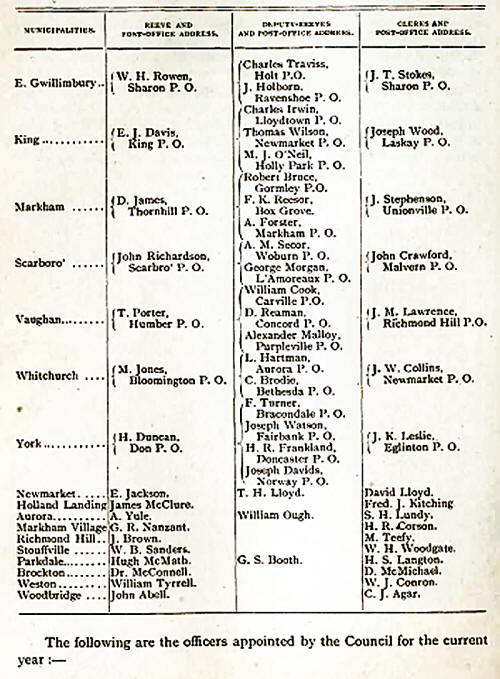
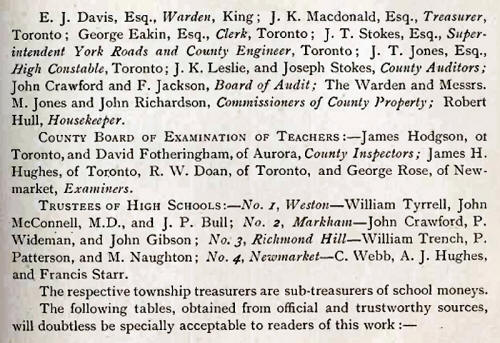
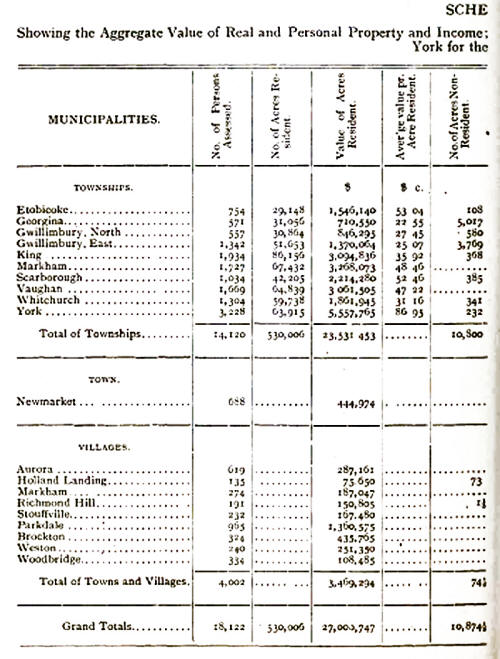
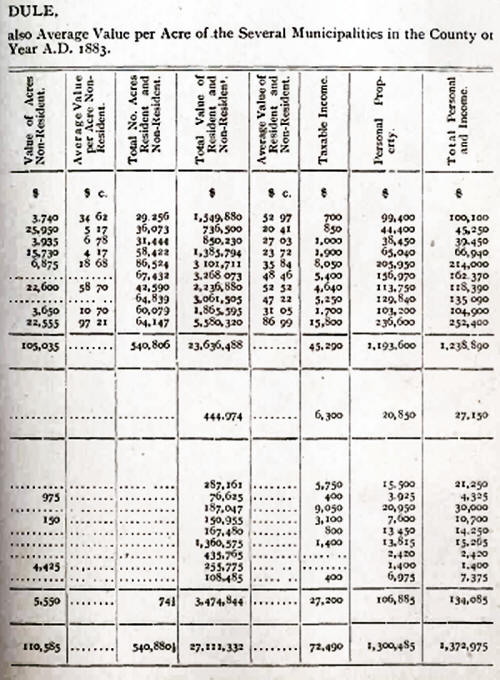
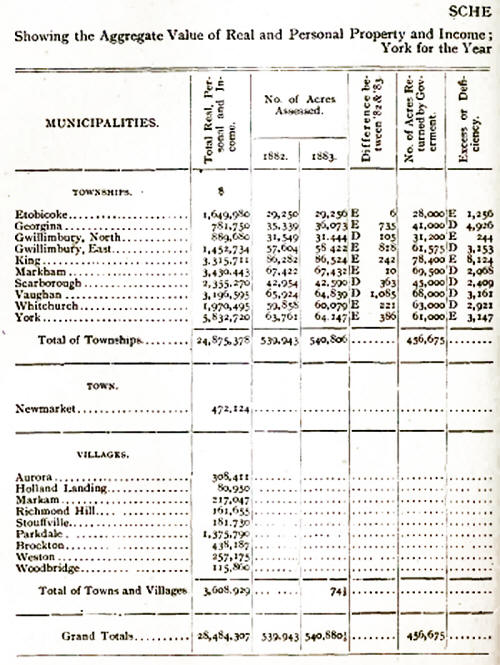
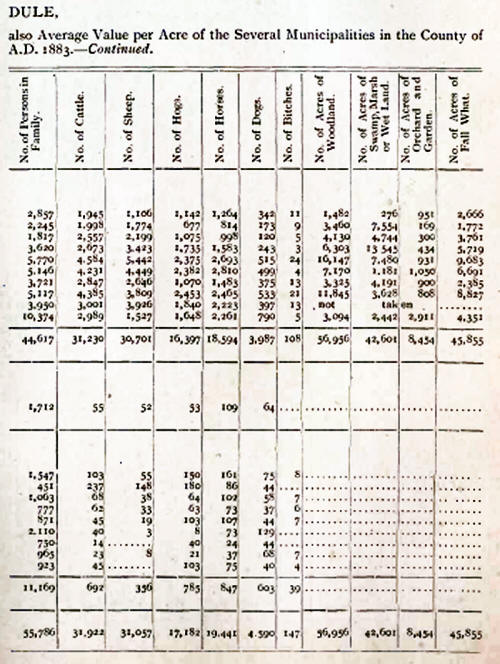
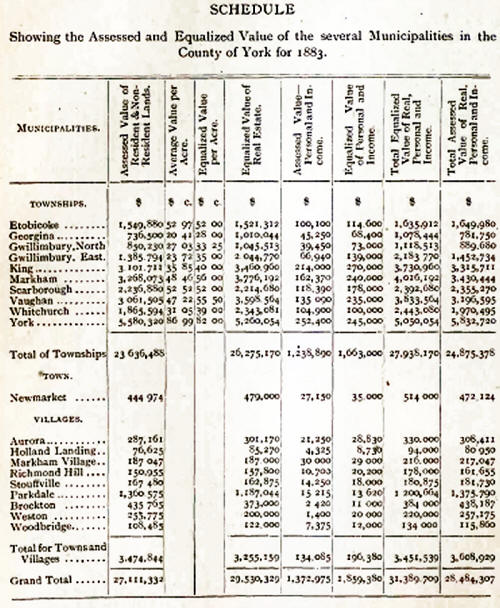 |
